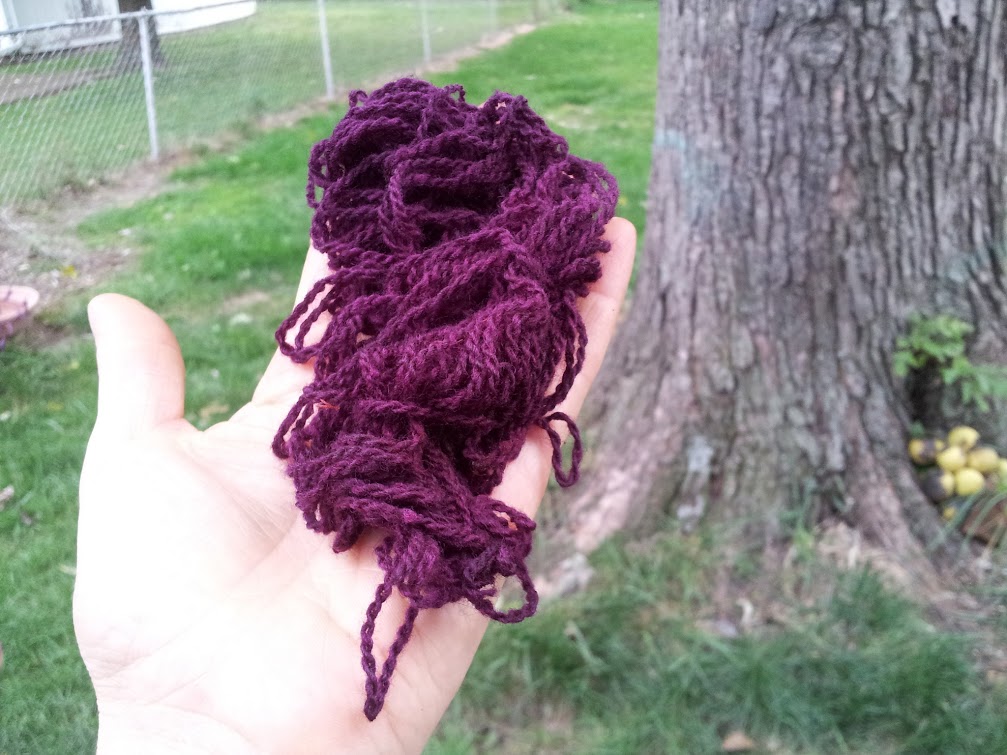
This whole dyeing thing never ceases to amaze me. Just when I think maybe I’ve figured something out, the dyepot decides to teach me a lesson.
Call me grasshopper.
Back in May when I started the monster avocado pit extraction, I made another little experimental extraction on the side. One day the kiddos were eating lychees, and I looked over and saw the pile of pits on the plate and a light bulb went off in my head: if avocado pits can dye things, maybe lychee pits can, too! So I took the pits and stuck them in a jar and covered them with ammonia and water just like I did for the avocado pits. And you know what happened? Let me show you…
Dye Notes:
Dyestuff: Lychee
Part used: Pits
Source: Grocery store/Asian market
Yarn: Lion Brand Fisherman’s Wool mordanted in 8% aluminum potassium sulfate and 7% cream of tartar

Ratio of dyestuff to fiber: I used 18 lychee pits, which weighed out to roughly 54g. The little skein of yarn was around 46g. So I had slightly better than a 1:1 ratio, bonus points to the dyestuff.
Extraction method: I left the pits whole and put them in a jar with a 1:1 ratio of water to ammonia. Started getting colour pretty fast.

This is just on day two. I added more pits over the next few days.
The extraction went from this clear red to couldn’t-see-through-it brown in under a month:

Total extraction time, approximately 5 months. I occasionally opened up the jar and shook it up to oxygenate the solution. I’ve read that it helps other extractions, so I figured why not. It never molded or got funky. Just got darker and darker.
Dyebath: So the pH of the lychee dye liquor was 9.8. The pH of my tap water is 8.8. Together they made a pH at room temperature of 9.1. I didn’t measure out the amount of water since it’s not supposed to effect saturation of the dye, but I’d guess about a gallon to a gallon and a half of tapwater to the one jar (maybe 12 oz) of dye liquor. I added the yarn and brought it up to a temperature window of 185-200F for an hour. At this temp, the pH was 6.6. Isn’t it amazing how much some of these solutions drop when heated? Maybe it’s not. I’m not a chemist, so I don’t know why it happens or if it effects the dye results, but I’d like to know. When I’ve got more time on my hands, I’m going to try to sort this out. Maybe someone’s done some research on it already… I did not add the actual pits to the dyebath since the dye liquor was so strong already.


I left the yarn to cool overnight. Only that turned into 2 nights. And when I checked on it, I was surprised by the utter lack of saturation of any good colour. Hmmmm.

So I decided to chop up the lychee pits, toss them in pantyhose and add the to the dyebath. I reheated the whole shebang again for another hour and left it overnight to cool one more time.
Results?
Nothing. Zilch. Next to no colour at all. WTH?

Rinsed and awaiting my disapproval.
Lesson learned? Just because you have a super saturated extraction doesn’t mean it will dye anything. Maybe I did something wrong? Maybe some dyestuffs just don’t dye well. Maybe this would have worked on silk or hemp better than wool? I don’t know, but I’d like to find out. I know that this lychee thing can work. I just have to figure out how… But listen, we can’t end on a lame bummer dye job. Besides this wasn’t a total FAIL, because the yarn was pretty much ready to overdye immediately. So overdye I did.
On to Walnut WIN!

The last time I tried dyeing with walnuts wasn’t so successful. I didn’t realize that though the nuts and shells will give off colour, it’s the green hulls that do the real dyeing. It took a failed dyebatch to learn that lesson. But learn it I did, and then I waited patiently for a new batch of walnuts to fall. Every autumn, my Gran asks for help clearing her yard of the millionty walnuts that fall from her neighbor’s tree. Usually she just chucks them back into her neighbor’s yard (which makes me grin), but this year I was only too happy to help. I took home two 5 gallon buckets, two 2 gallon bucket, and 3 trash bags full of walnuts. That’s a lotta nuts. I made the mistake of setting them outside until I could soak them. We’ve got very, very ballsy squirrels in the city. They helped themselves to quite a few of the nuts, tearing right into the trash bags to get them. So much so, that I finally made a peace offering and emptied the remains of the 3 trash bags under the tree where our squirrel family lives. I figured, they’ve got to survive the winter. I just need some dye to play with. No contest. I did keep the two 5 gallon buckets and filled them with water. After the squirrels took all the nuts under the tree—ALL OF THEM—they actually started taking walnuts out of the water in the big buckets. So I replenished those with what was left in the 2 gallon buckets and then covered them. I don’t know if it’ll be squirrel proof, what is? But it seems to have slowed them down. Enough for me to get one batch of dye, anyway.
Dye Notes:
Dyestuff: Black Walnut (juglans nigra)
Part used: Green hulls
Source: The Haggencrone’s yard
Yarn: Lion Brand Fisherman’s Wool mordanted with 8% aluminum potassium sulfate and 7% cream of tartar
Ratio of dyestuff to fiber: No clue. I just poured about a gallon of the dye liquor out of the bucket. Again, it’s about a 46g hank of wool yarn.
Extraction method: This is a pretty fresh batch of walnut juice. It’s only been soaking in water for about a week or so. Doesn’t take long to get good colour of of the hulls. I’m told, though, that letting it all mold and ferment just makes for richer, darker browns. It’ll be interesting to see what I get as time goes by.

Could totally do some scrying in this pot.
Dyebath: The pH of the dyebath at room temp was 6.2. I heated the dyebath to a temperature window between 185-200F. The pH at 198F was 5.9. I held the dyebath in this temperature window for just over an hour and then let the yarn cool in the bath overnight.

The Results?
Mad awesome brown. Here it is fresh from the dyepot, rinsed and hanging to dry:

And here it is after drying:

This looks a smidge brighter since it’s in full sun. It’s actually a little darker than this. I’m really pleased with the results. I’ll do a lightfastness test, but anticipate that it’ll hold up pretty well. I opted not to modify with iron, because I really like the colour as is, but I would like to play around with some iron in the dyepot and as an afterdip. Now I have to figure out what to knit…
Live happy, dye happy!
Posted in
dyeing of natural causes and tagged
aluminum potassium sulfate,
ammonia,
crafts,
dye,
dye plants,
dyeing,
dyeing of natural causes,
dyeing with lychee,
dyeing with walnut,
dyes,
lion brand,
lychee fruit,
lychee pits,
natural dye,
natural dyeing,
nature,
plants,
squirrels,
walnut,
walnut hulls,
walnut stain,
wool,
yarn

 So far, I think everything is as should be expected. We know that pokeberry is not normally lightfast, but that with proper mordanting and dyeweight ratios, can be made more so. You can see a substantial difference in the lightfastness between the original dyebath and the two exhaust baths. Here is the good news. This lightfastness test was conducted in a room in my house lovingly known as The Snug, short for Snuggery, aka the Sun Room. It is a very tiny little nook of a room made entirely of mullioned windows. For the purposes of this post, that means that anything in the room gets not only full south-facing sun, but also east and west sun, as well. The photos you’ve seen so far are of the side of the yarn which had direct south-facing exposure pressed right up on the glass. The next series of photos are of the back side of the exposed yarn—the side exposed to normal daily levels of ambient light from the east and west windows. You can just see the outlines of the direct-exposed areas. It’s like the yarn has tan lines. Look at this:
So far, I think everything is as should be expected. We know that pokeberry is not normally lightfast, but that with proper mordanting and dyeweight ratios, can be made more so. You can see a substantial difference in the lightfastness between the original dyebath and the two exhaust baths. Here is the good news. This lightfastness test was conducted in a room in my house lovingly known as The Snug, short for Snuggery, aka the Sun Room. It is a very tiny little nook of a room made entirely of mullioned windows. For the purposes of this post, that means that anything in the room gets not only full south-facing sun, but also east and west sun, as well. The photos you’ve seen so far are of the side of the yarn which had direct south-facing exposure pressed right up on the glass. The next series of photos are of the back side of the exposed yarn—the side exposed to normal daily levels of ambient light from the east and west windows. You can just see the outlines of the direct-exposed areas. It’s like the yarn has tan lines. Look at this:









































































